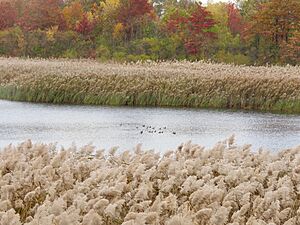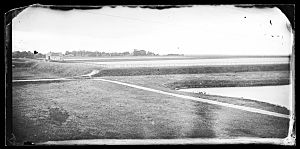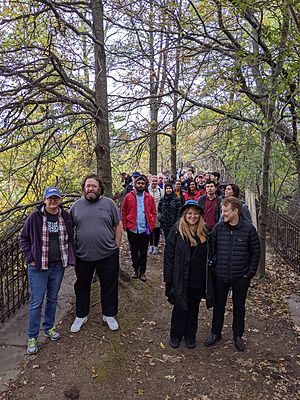Ridgewood Reservoir facts for kids
Quick facts for kids |
|
|
Ridgewood Reservoir
|
|

Aerial photo showing the three basins of the reservoir with the Manhattan skyline in the background, February 2020
|
|
| Location | Jackie Robinson Parkway, Vermont Place, Cypress Hills Street, & Highland Boulevard |
|---|---|
| Area | 50 acres (20 ha) |
| Built | 1856-1858 |
| Engineer | James P. Kirkwood of H.S. Welles & Co. |
| Architectural style | Romanesque Revival |
| NRHP reference No. | 100002074 |
| Added to NRHP | February 2, 2018 |
The Ridgewood Reservoir is an old water storage area from the 1800s. It is now a freshwater wetland (a marshy area). This special place sits right on the border between Brooklyn and Queens in New York City. It is part of Highland Park.
Even though it helped supply water to the City of Brooklyn, the reservoir is actually located in the Glendale neighborhood of Queens. The reservoir and park are surrounded by the Jackie Robinson Parkway to the north, Highland Boulevard to the south, Vermont Place to the west, and Cypress Hills National Cemetery to the east.
The reservoir got its name from the Ridgewood Ponds in Nassau County. These ponds were one of the main places where the reservoir got its water. Because of this, the area north of the reservoir became known as Ridgewood.
After the reservoir was no longer used, it slowly turned into a rich freshwater wetland. This natural area became home to many different animals and plants. Some of these species are rare or endangered, like the Short-eared Owl and the Pied-billed Grebe. A bike path around the reservoir is now part of the 40-mile (64 km) Brooklyn–Queens Greenway.
For many years, between 2004 and 2017, people wondered what would happen to the Ridgewood Reservoir. The New York City Parks Department and the New York State DEC (Department of Environmental Conservation) had plans that would have changed the reservoir's basins. These plans would have disturbed the natural wetland. However, local community groups worked hard to protect the reservoir's natural setting. Their efforts stopped these plans. In 2018, the reservoir was added to the National Register of Historic Places. It was also officially named a Class I freshwater wetland by the New York State DEC. This means it will be kept as a natural space.
Contents
Building the Ridgewood Reservoir
Why Brooklyn Needed Water
In the 1800s, the City of Brooklyn was growing very fast. It needed more water than its local sources could provide. In 1851, Brooklyn worried it was losing out on new businesses. These businesses might have moved to Brooklyn if it had a reliable water supply, like New York City's Croton Aqueduct.
People suggested different water sources. The Croton River was already used by New York City and couldn't supply Brooklyn too. The Bronx River didn't have enough water and was hard to reach. Wells in and near Brooklyn weren't good enough in quantity or quality. There were only a few natural lakes on Long Island, and they couldn't provide enough water either. The best idea was to collect water from many small streams on Long Island. This water would then be sent to Brooklyn and lifted into a high reservoir.
How the Reservoir Was Built
The first plans for the Ridgewood Reservoir were made by Samuel McElroy, a civil engineer from Brooklyn. His original design included three basins. However, another engineer named James P. Kirkwood changed the plans. He decided to build a double basin instead.
This new double reservoir was built on a hilltop near Evergreen Cemetery. This area was once part of Ridgewood, Queens, but it is now part of Glendale. The reservoir was sealed with clay using a method called puddling. Its walls were built with fieldstone and mortar. Construction started on July 11, 1856. Water first filled the reservoir on November 18, 1858.
By 1862, the reservoir got its water from six streams that were dammed. These streams were in what is now Queens and Nassau Counties. They included Jamaica Stream (Baisley Pond), Simonson's Stream, Clear Stream, Valley Stream, Pine's Stream, and Hempstead Stream (Hempstead Lake).
This water traveled through a 12-mile-long stone pipe, called the Ridgewood Aqueduct. It went to a pumping station at Atlantic Avenue and Chestnut Street. There, powerful steam-powered pumps pushed the water up into the high reservoir. From there, the water was sent out to the city. By 1868, the Ridgewood Reservoir held about 154.4 million gallons of water every day. This was enough to supply the City of Brooklyn for ten days.
The Ridgewood Reservoir was special for its time because it used driven wells. An article from 1886 in Scientific American magazine praised the reservoir's well system. It said the plans were "original and bold" and that they achieved "perfect success."
Expanding the Water System
Over the next few decades, Brooklyn's water system grew. More wells and collection reservoirs were added. The water pipe was extended further east, and more pumps were installed. The third basin of the Ridgewood Reservoir was finished in 1891. Farmers in southern Queens County complained that Brooklyn's need for water was lowering the water table (the level of water underground).
Later in the 1800s, the water pipe was extended to a large pumping station in Massapequa, about 30 miles (48 km) away. Plans to extend it even further were stopped by laws protecting the water in Suffolk County. In the early 1900s, roads like Force Tube Avenue, Conduit Boulevard, and Sunrise Highway were built partly over or along the water pipe's path.
Highland Park was created on land right around the Ridgewood Reservoir. The City of Brooklyn bought this land in 1891. The park was built between 1901 and 1906. It also included more land bought to the south and west.
When the Reservoir Stopped Being Used
In 1898, Brooklyn became part of the City of Greater New York. This gave Brooklyn access to New York City's much bigger and better New York City water supply system. The Ridgewood Reservoir was expensive to run because it needed pumps. It slowly became unnecessary as New York City's Catskill and Delaware water systems expanded.
The Ridgewood Reservoir became a backup water source in 1959. Its third basin was filled with water from the Catskill system. The reservoir was last used during a drought in the 1960s. In the 1970s, people sometimes swam in the reservoir, which was not safe. The reservoir was finally taken out of service and drained in 1989.
Some of the old pumping stations in Nassau County, like the one at Milburn (now Baldwin), still exist as ruins today. Valley Stream State Park, Hempstead Lake State Park, and other parks on the South Shore of Long Island were originally reservoirs for Brooklyn's water system.
In 2004, the reservoir was officially given to the Department of Parks. This allowed it to become a bigger part of Highland Park.
A Special Place for Nature
Since the Ridgewood Reservoir was no longer used for water, it has naturally grown into a thriving wetland. It now has many different natural areas. These include woodlands, swamps, standing water wetlands, coastal swamp forests, bogs, and open grassy areas.
The reservoir is home to a wide variety of plants and animals. There are 156 different kinds of birds, 175 plant species, and many types of insects. This growing freshwater spot is an important stop for birds flying along the Atlantic Flyway. It is a popular place for people who enjoy watching birds. The reservoir's unique natural setting also makes it a frequent spot for school field trips and walking tours.
Currently, the pond in the middle basin of the reservoir is being taken over by invasive weeds called Phragmites. If these weeds are not controlled, they could outcompete the reservoir's natural plants and fill in the pond. Community groups are working to control the Phragmites by cutting them underwater and removing their roots. These efforts are still ongoing.
In January 2019, the NYC Parks Department named the Ridgewood Reservoir a "Critical Environmental Area." This means the reservoir is a "naturalized area that is unique within New York City." It is an important place for nature, history, and public recreation.







